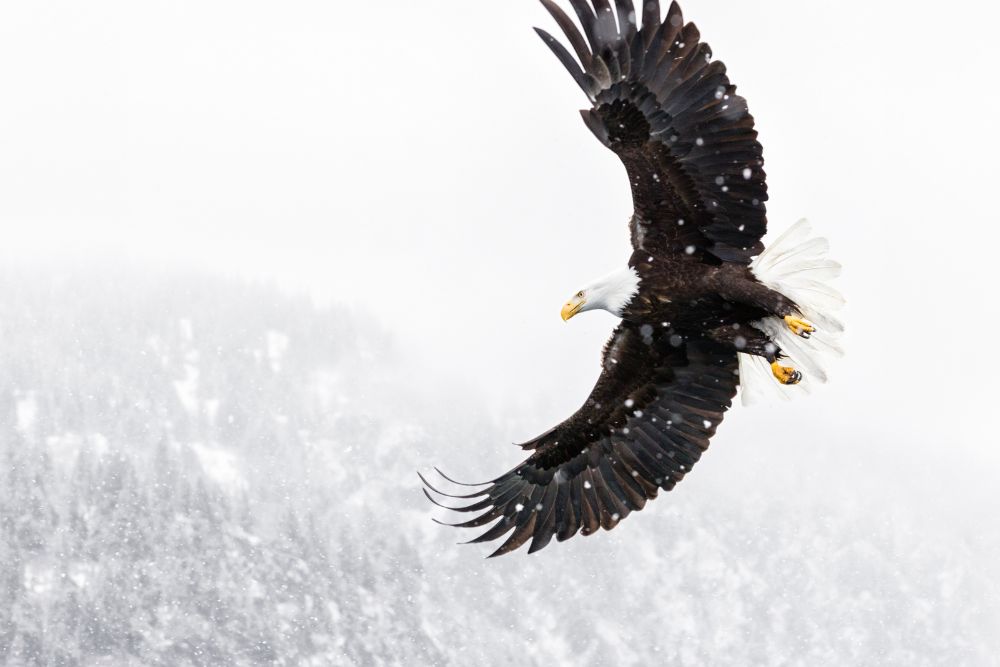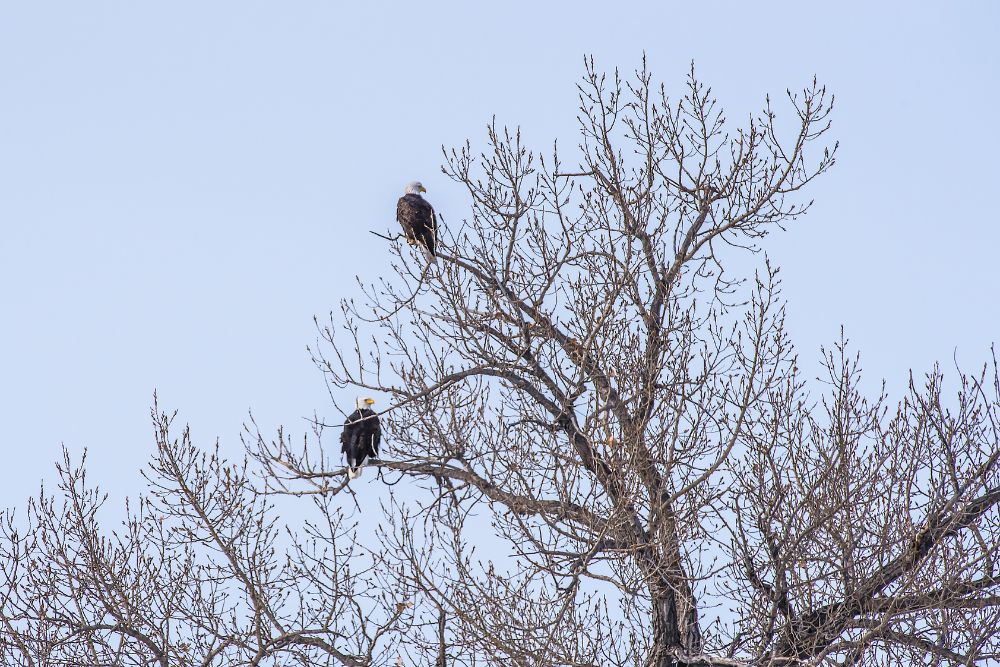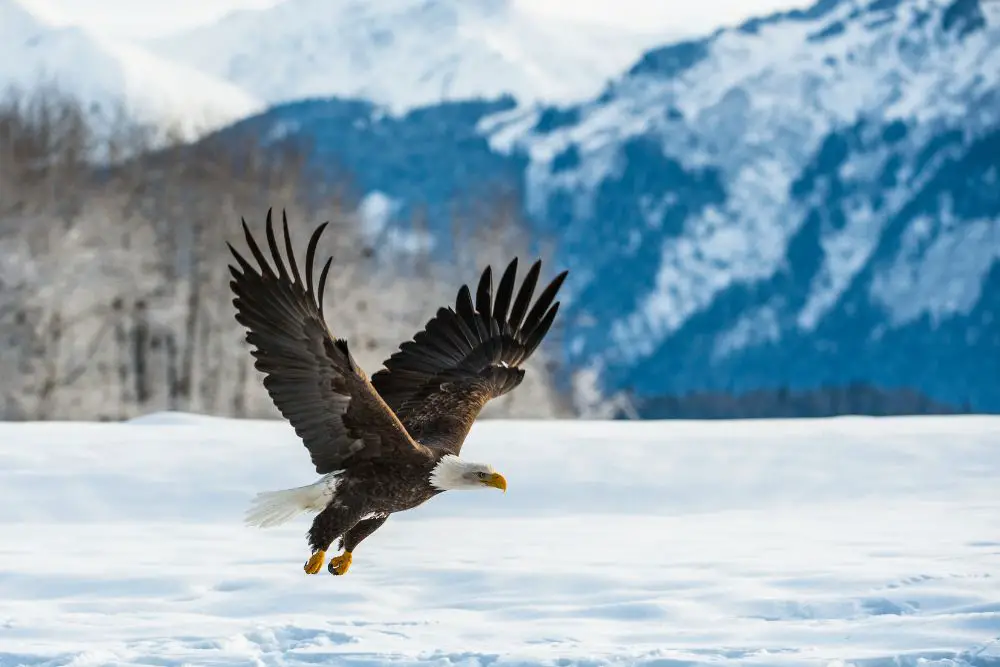How Cold Can Bald Eagles Survive? – Surviving the Chill
Bald eagles, the majestic icons of North America’s skies, have captivated our imagination with their regal presence and impressive aerial displays.
But have you ever wondered how these magnificent creatures endure the frigid temperatures of their habitats?
In this article, we will delve into the question, “How cold can bald eagles survive?” and unravel the remarkable cold tolerance of these feathered inhabitants.
Bald eagles can endure extreme temperatures ranging from 0°F to -30°F. While some migrate to warmer areas, many choose to brave the freezing conditions in their familiar territories.
To comprehend the astonishing cold tolerance of bald eagles, we will explore the fascinating adaptations and survival strategies they employ.
From their feather insulation, which acts as a cozy barrier against the biting chill, to their remarkable ability to regulate blood flow and maintain internal warmth, these birds have developed various biological mechanisms to withstand the harshest winters.
Join us on this journey of discovery as we unravel the secrets behind the survival of bald eagles in extreme cold.

How Cold Can Bald Eagles Survive?
To understand the cold reliance of the bald eagle, there are a few things that you need to be aware of.
Let’s take a look at each of these factors that makes the mighty bald eagle able to survive the bone-chilling cold winters of the Alaskan region.
The Remarkable Feather Structure of Bald Eagles
The feathers of bald eagles are designed to provide exceptional insulation. They have a complex structure that consists of multiple layers.
The outer layer, known as the vanes, comprises interlocking barbs. This structure helps to trap air, creating a layer of insulation against the cold.
The inner layer, known as down feathers, is soft and fluffy, providing additional warmth by trapping heat close to the bird’s body.
Feather Adaptations for Enhanced Insulation
Bald eagle feathers have several adaptations that enhance their insulating properties.
The barbs of their feathers have tiny hooks called barbules, which interlock with neighboring barbules, creating a tightly woven surface.
This interlocking structure prevents air from escaping and minimizes heat loss.
Additionally, bald eagle feathers have a dense distribution of feather filaments, providing an extra layer of insulation.
Waterproofing Feathers
Bald eagles have a specialized gland called the preen gland located near the base of their tail.
This gland produces an oil the eagles spread over their feathers during preening.
The oil contains waterproofing agents, which help to repel water and prevent the feathers from becoming saturated.
By keeping their feathers dry, bald eagles can maintain their insulating properties even in wet and cold conditions.

Blood Flow Regulation
To regulate their body temperature, bald eagles can control blood flow. When it is cold, they can reduce blood flow to their extremities, such as their legs and feet, which minimizes heat loss.
By redirecting warm blood to their core organs, including their heart and vital organs, they can maintain their body temperature and prevent excessive heat loss in cold environments.
Nesting Habits and Winter Survival Adaptations
In addition to the physical characteristics of these majestic birds, eagles’ distinct nesting habits also contribute to their winter survival in cold regions.
Selecting Nest Sites in Cold Regions:
Bald eagles carefully choose nest sites in cold regions to mitigate the impact of harsh weather.
They prefer locations that provide protection from strong winds, such as the sheltered branches of tall trees.
These elevated sites also offer a vantage point for hunting and monitoring their surroundings.
At the same time, the dense tree branches help to reduce the harsh cold wind from blowing into their nests.
Even if there aren’t a lot of leaves in the trees, you might have noticed that the bald eagle’s nest will be in a tall tree with many branches.
Building and Maintaining Nests for Insulation:
Bald eagles construct large nests called eyries. These nests are built using a combination of sturdy branches, twigs, and soft materials like moss and grass.
The inner layers are lined with softer materials, including feathers and down, providing additional insulation.
By creating well-insulated nests, bald eagles ensure warmth for themselves and their young during winter.
Eagles are known for taking better care of their babies. Therefore, they strive to protect their young ones from the harsh cold, especially during the December and January days.
Huddling Behavior: Communal Roosting for Shared Warmth
During extremely cold weather, bald eagles exhibit a behavior known as huddling.
Multiple eagles gather together, often in groups of three or more, to share body heat and collectively withstand the low temperatures.
By huddling, they can conserve energy and maintain their body temperature, ensuring their survival in freezing environments.
Actually, the released temperature from their bodies allows them to soothe each other.

Sunbathing and Solar Orientation: Maximizing Heat Absorption
Bald eagles take advantage of the limited sunlight during winter by engaging in sunbathing and solar orientation.
They position themselves to face the sun, spreading their wings to expose their dark feathers to the sunlight.
The dark feathers absorb and retain heat, helping to warm their bodies.
By utilizing solar radiation, bald eagles optimize their heat absorption and regulate their body temperature in cold weather.
Through their nesting habits and winter survival adaptations, bald eagles create warm sanctuaries and develop strategies for enduring harsh conditions.
By selecting suitable nest sites, building well-insulated nests, engaging in huddling behavior, and utilizing solar orientation, these magnificent birds demonstrate their ability to thrive even in the coldest environments.
Hunting Strategies of Bald Eagles in Cold Environments
When it comes to withstanding the deadly cold winters, only a secured nest and a well-developed body is not enough. These majestic birds of prey have to find food that can constantly help them develop energy.
Bald eagles have developed specialized hunting strategies to overcome food scarcity and thrive in cold environments, particularly in Arctic regions.
Adaptations for Hunting in Icy Waters
In Arctic environments, bald eagles encounter icy waters, which present unique challenges for hunting. To overcome this obstacle, they have adapted certain techniques.
One such adaptation is their sharp, powerful talons. These formidable claws allow them to grasp and capture prey, even in slippery and icy conditions.
Additionally, bald eagles possess exceptional eyesight, allowing them to spot potential prey from a great distance, even when submerged beneath the icy surface.
Opportunistic Feeding: Exploiting Seasonal Prey Availability
Food availability can vary greatly in cold environments with the changing seasons. Bald eagles exhibit opportunistic feeding behaviors, taking advantage of seasonal prey availability.
During winter, when open water bodies may be limited, they focus on scavenging and feeding on carrion.
They opportunistically target carcasses of fish, waterfowl, and other animals that have succumbed to the harsh conditions.
This scavenging behavior allows them to sustain themselves during times of reduced hunting opportunities.
Bald Eagle Migration: Brave Journeys through Chilling Landscapes
Bald eagles are known for their impressive long-distance migration, embarking on brave journeys across chilling landscapes.
Migration is primarily driven by the search for food and suitable breeding grounds.
These magnificent birds undertake extensive travels, often spanning thousands of miles, to reach their desired destinations.
Challenges Faced During Migration in Cold Weather
Migration in cold weather presents several challenges for bald eagles.
They encounter harsh conditions such as strong winds, freezing temperatures, and limited food sources along their migratory routes.
The need to find open water bodies and avoid ice-covered territories adds complexity to their journey.
Bald eagles must navigate these adversities, utilizing their physical adaptations and instincts to ensure their survival during the demanding migration process.
Site Fidelity in Bald Eagles: Returning to Familiar Cold-Weather Habitats
Bald eagles exhibit a remarkable behavior known as site fidelity, where they return to familiar cold-weather habitats year after year.
This behavior demonstrates their strong attachment to specific territories and their ability to remember and navigate back to these locations.
Site fidelity plays a crucial role in their winter survival and breeding success.

Maintaining Territories in Alaska and Northern Canada
In the cold regions of Alaska and Northern Canada, bald eagles establish and maintain territories with great dedication.
These territories provide them with access to abundant food sources and suitable nesting sites.
By returning to the same territories each year, bald eagles capitalize on their familiarity with the area, optimizing their chances of finding food and successfully raising their young.
Site fidelity not only ensures the availability of vital resources but also helps in establishing social hierarchies and reducing conflicts among individuals.
By defending their territories, bald eagles can secure their winter survival and increase their chances of passing on their genes to the next generation.
Bald Eagle Eggs, Incubation, and Survival in Cold Weather
Bald eagle eggs are precious and require careful incubation to ensure successful development.
Both male and female eagles take turns incubating the eggs, sharing the responsibility of keeping them warm.
They use their body heat and specialized brood patches, featherless areas with increased blood supply, to maintain an optimal temperature for egg development.
However, incubating eggs in frigid conditions presents unique challenges for bald eagles.
Cold temperatures can pose a threat to the viability of the eggs, as extreme cold may lead to reduced embryonic development or even egg mortality.
However, the parents’ diligent incubation and the insulating properties of the nest help mitigate these challenges, ensuring the survival and healthy development of the embryos.
The Miracle of Survival: Raising Eaglets in Icy Nests
Bald eagle parents demonstrate exceptional care and dedication in raising their eaglets in icy nests. They protect the young from the cold by providing constant coverage and insulation.
The adult eagles bring food to the nest, ensuring a steady supply of nourishment for their growing offspring. The parents’ diligence in hunting and providing for the eaglets is essential for their survival in the challenging cold environments.
As the eaglets grow and develop, they undergo a process called fledging, where they gain strength and learn essential skills for their own survival.
The parents continue to guide and teach them, gradually reducing their dependence on the nest.
Through practice flights and hunting lessons, the young eaglets acquire the necessary abilities to navigate the harsh environment and secure their own food sources.
Climate Change and Its Impact on Bird Survival in Extreme Cold
Climate change is causing significant changes in Arctic environments, with rising temperatures leading to the loss of sea ice and alterations in ecosystems.
The Arctic is a critical habitat for bald eagles during breeding and wintering.
However, the diminishing sea ice and changing patterns of prey availability directly impact the eagles’ food sources and nesting habitats.
Shifting environmental conditions may disrupt prey availability, affecting the eagles’ foraging success and overall population health.
Additionally, alterations in nesting habitats, such as thawing permafrost and changing vegetation patterns, can negatively affect their breeding success and overall reproductive capacity.
Last Minute Thoughts!
Bald eagles have demonstrated their remarkable resilience in thriving in freezing conditions.
Their ability to withstand extreme cold temperatures, navigate icy landscapes, and adapt their hunting strategies showcases their unique adaptations and survival mechanisms.
From their feather insulation and thermal regulation to their nesting habits and care for their young, bald eagles have evolved to endure and prosper in cold environments.
I hope, you found this article informative, helpful and interesting. If you enjoyed reading it please don’t forget to share it with your friends and family too!







